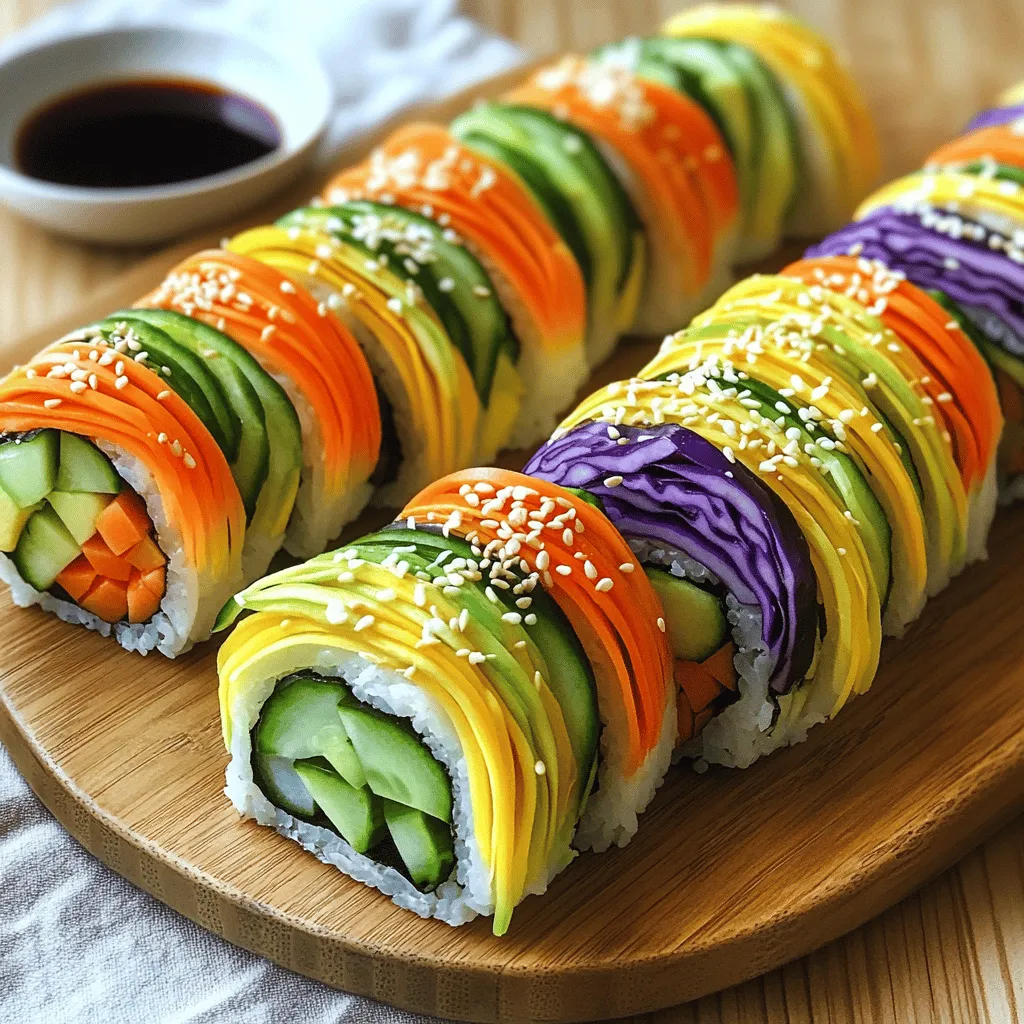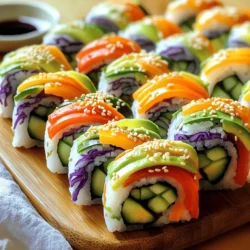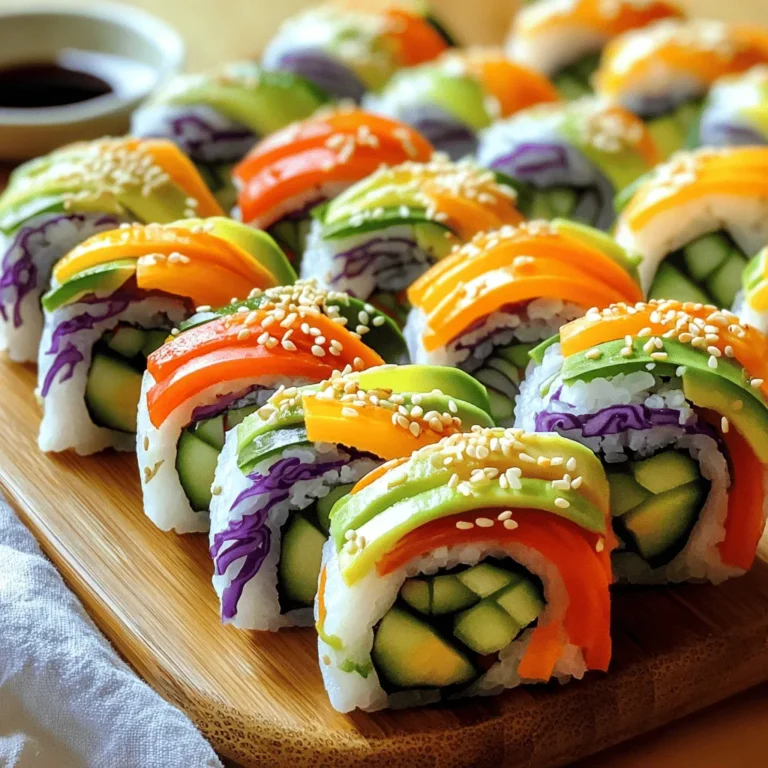Ready to roll? Dive into the colorful world of Rainbow Veggie Sushi Rolls! This fresh and vibrant recipe is perfect for anyone looking to enjoy a healthy meal that’s both fun and delicious. You’ll learn how to make sushi rice, choose the best veggies, and assemble perfect rolls. Plus, I’ll share tips for flavoring them and keeping them fresh. Let’s get started on this tasty adventure!
Ingredients
Main Ingredients Required
– 1 cup sushi rice
– 1 1/4 cups water
– 4 sheets of nori (seaweed)
– 1 small cucumber, julienned
– 1 medium carrot, julienned
– 1/2 bell pepper (red, yellow, or orange), thinly sliced
– 1 avocado, sliced
– 1/4 cup purple cabbage, finely shredded
When I make rainbow veggie sushi rolls, I start with sushi rice. This rice is sticky, which helps the rolls hold together. I rinse it under cold water until the water runs clear. This step removes excess starch and makes the rice fluffy. Next, I combine the rinsed rice and water in a pot. I bring it to a boil, then simmer. After about 18 minutes, the water should be absorbed.
Nori is the seaweed that wraps the sushi. It comes in sheets and has a slightly salty flavor. I love using fresh vegetables like cucumber, carrot, bell pepper, avocado, and purple cabbage. These veggies add color and crunch to each bite.
Additional Seasonings
– 1 tablespoon rice vinegar
– 1 teaspoon sugar
– 1/2 teaspoon salt
For flavor, I mix rice vinegar, sugar, and salt in a bowl. I heat this mixture briefly until the sugar dissolves. It adds a tangy taste to the rice. I let it cool before folding it into the rice. This step is crucial for a well-balanced flavor.
Garnishes and Dipping Sauces
– Sesame seeds
– Soy sauce
To finish, I sprinkle sesame seeds on top of the rolls. They add a nice crunch and nutty flavor. I always serve the sushi with soy sauce for dipping. This classic sauce enhances the taste and makes each bite even better.
Step-by-Step Instructions
Preparing the Sushi Rice
Rinsing the rice
Start by rinsing 1 cup of sushi rice under cold water. Keep rinsing until the water runs clear. This step removes excess starch. It helps the rice cook better.
Cooking the rice
Combine the rinsed rice and 1 ¼ cups of water in a pot. Bring it to a boil. Once boiling, reduce the heat to low. Cover the pot and let it simmer for about 18 minutes. The rice will absorb all the water. After 18 minutes, remove it from heat. Let it sit, covered, for 10 minutes.
Flavoring the Rice
Combining rice vinegar, sugar, and salt
In a small bowl, mix 1 tablespoon of rice vinegar, 1 teaspoon of sugar, and ½ teaspoon of salt. Microwave this mixture for about 30 seconds. This helps the sugar dissolve.
Folding in the vinegar mixture
Let the vinegar mixture cool slightly. After the rice has rested, transfer it to a bowl. Gently fold in the vinegar mixture until the rice is evenly coated. Allow the rice to cool to room temperature.
Preparing the Vegetables
Cutting techniques for vegetables
While the rice cools, prepare your vegetables. Use a julienne peeler or knife to cut the cucumber and carrot into thin strips. Thinly slice the bell pepper. Cut the avocado into long slices.
Tips for uniform slicing
For even pieces, keep your knife steady. Use a sharp knife to avoid crushing the vegetables. This makes the sushi look nice and fresh.
Assembling the Sushi Rolls
Using the bamboo mat
Place a bamboo sushi mat on a flat surface. Lay a sheet of nori, shiny side down, onto the mat. This helps you roll the sushi easily.
Spreading the sushi rice on nori
Wet your hands to prevent sticking. Spread about ¼ of the sushi rice evenly over the nori. Leave about an inch at the top edge. This edge will help seal the roll later.
Rolling and Slicing the Sushi
Tips for rolling tightly
Layer a few pieces of each vegetable across the center of the rice. Start rolling the sushi tightly from the bottom. Use the bamboo mat to help. Press gently but firmly as you roll. Make sure the top edge is wet to seal the roll.
Slicing technique for clean cuts
Use a sharp, wet knife to slice each roll into 6-8 pieces. Wipe the knife with a damp cloth between cuts for cleaner slices. This keeps your sushi looking great.Enjoy your colorful and tasty rainbow veggie sushi rolls!
Tips & Tricks
Perfecting the Sushi Rice
To make perfect sushi rice, use a 1:1.25 rice-to-water ratio. This helps the rice cook just right. Rinse the sushi rice under cold water until the water runs clear. This removes excess starch and keeps the rice from getting gummy. After cooking, let the rice sit covered for ten minutes. This allows the steam to finish the cooking process.
Once the rice is ready, cool it down quickly. Spread it on a large plate or a baking sheet. A fan can help cool the rice faster. Make sure it reaches room temperature before you use it.
Vegetable Selection
For colorful sushi, choose fresh veggies. Good options include cucumber, carrots, bell peppers, and avocado. Use bright colors to make your rolls pop. Purple cabbage adds a nice crunch and a splash of color.
Store your vegetables in the fridge until you are ready to use them. This keeps them fresh and crisp. Cut them just before making the sushi for the best taste.
Achieving the Perfect Roll
Wetting your hands is key to rolling sushi. This prevents the rice from sticking to your fingers. After you spread the rice on the nori, start layering your veggies.
When you roll, press gently but firmly. This keeps the roll tight. Make sure the top edge of the nori is wet. This helps seal the roll and keeps it together. If it’s not sealed well, it may fall apart when you slice it.

Variations
Alternative Fillings
You can change up the veggies in your sushi rolls. Try radishes for crunch or sweet bell peppers for flavor. You can also use other fresh greens like spinach or arugula. If you want more protein, add tofu or shrimp. Tofu is great because it soaks up flavors well. Shrimp adds a savory touch that many will love.
Different Flavor Profiles
Adding sauces can make your sushi even better. Consider a sweet chili sauce for a hint of spice. You might also try a drizzle of sesame oil for depth. To brighten the rolls, add fresh herbs like cilantro or mint. A squeeze of lime or lemon can also add zing.
Dietary Adjustments
If you need gluten-free sushi, look for rice paper instead of nori. This option works well and tastes good, too. For a vegan version, skip any shrimp and stick with veggies. You can also use avocado for creaminess. Both options keep your sushi healthy and colorful.
Storage Info
Short-term Storage
To keep your rainbow veggie sushi rolls fresh overnight, wrap them tightly in plastic wrap. This helps prevent air from drying them out. Store the wrapped rolls in the fridge. They can stay fresh for about 24 hours. Avoid cutting the rolls until you’re ready to eat. This keeps the edges intact and fresh.
Long-term Storage
You can freeze sushi rolls for longer storage. Wrap each roll in plastic wrap, then place them in a freezer bag. They can be frozen for up to three months. When you want to eat them, move the rolls from the freezer to the fridge to thaw. This method works well for meal prep too. Just make sure to prepare your veggies and rice ahead of time.
Reheating Tips
Sushi isn’t usually reheated, but if you want to warm it, use a microwave. Place the sushi on a plate and cover it with a damp paper towel. Heat for about 10-15 seconds. This helps keep the rice moist. Avoid overheating, as it can ruin the texture. Enjoy your sushi fresh or slightly warmed!
FAQs
How do I make sushi rice from scratch?
To make sushi rice, rinse 1 cup of sushi rice under cold water until the water runs clear. Combine it with 1 1/4 cups of water in a pot. Bring it to a boil, then lower the heat. Cover and cook for about 18 minutes until the water is gone. Let it sit covered for 10 minutes. This step is key; it helps the rice steam and become sticky.
Common mistakes:
– Not rinsing the rice enough; this can make it too starchy.
– Cooking at too high a heat; this can burn the rice.
– Forgetting to let it sit after cooking; this is crucial for the right texture.
Can I use brown rice instead of sushi rice?
Yes, you can use brown rice. It has more fiber and nutrients. However, it is chewier and takes longer to cook. Sushi rice is sticky and soft, perfect for rolling.
Pros of brown rice:
– Healthier; more fiber and nutrients.
– Nutty flavor.
Cons of brown rice:
– Not as sticky; harder to roll.
– Longer cooking time; usually about 45 minutes.
What are the best dipping sauces for sushi?
While soy sauce is popular, don’t stop there! You can try other sauces for more flavor.
Popular options:
– Wasabi; adds a spicy kick.
– Ponzu sauce; a tangy citrus blend.
– Spicy mayo; mix mayo with sriracha for heat.
– Sesame oil; for a nutty flavor.
How do I store leftover sushi rolls?
Store leftover sushi rolls in an airtight container. This keeps them fresh. Place a damp paper towel in the container to help maintain moisture.
Tips for freshness:
– Eat sushi within a day; it tastes best fresh.
– Do not freeze sushi; the texture can change.
– Keep it in the fridge; this helps with safety and taste.
Making sushi at home is simple and fun. We covered key ingredients, from sushi rice to fresh veggies. I shared step-by-step instructions to prepare and roll your sushi perfectly. Remember to choose vibrant vegetables and try new flavors. Storing sushi properly helps keep it fresh. Now, you have everything to create delicious sushi rolls. Enjoy experimenting and customizing your own sushi at home!


